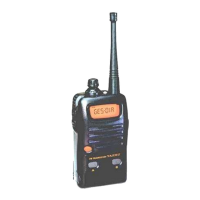-Spurious
Suppression
Generation
of
spurious
products
by
the
trans-
mitter
is
minimized
by
the
fundamental
carrier
frequency
being
equal
to
the
final
transmitting
frequency,
modulated
directly
in
the
transmit
VCO.
Additional
harmonic
suppression
is
pro-
vided
by
a
low-pass
filter
consisting
of
L1006,
L1007
& L1008
and
C1033, C1034, C1046, C1048,
C1049
& C1050,
resulting
in
more
than
60
dB of
harmonic
suppression
prior
to
delivery
to
the
antenna.
PLL
Frequency
Synthesizer
,-,. PLL
circuitry
on
the
RF
Unit
consists of
VCO
Q1002 (2SC5231C8/C9)
and
VCO
buffers Q1003
(2SC5231C8/C9), Q1006 ( 2SC4245);
PLL
sub-
systemIC
Q1015 (MC145192F),
which
contains
a
reference
divider,
serial-to-parallel
data
latch,
programmable
divider,
phase
comparator,
charge
pump,
and
a
power
saver
circuit.
Stability is
maintained
by
a
regulated
3 V
sup-
ply
via Q2014 (2SB1132Q)
on
the
CNTL
Unit
to
Q1018,
temperature
compensating
thermistor
and
capacitors
associated
with
the
17.25
MHz
frequency
reference
crystal
X1001.
-
While
receiving,
VCO
Q1002
oscillates
be-
.ween
116.3
and
156.3
MHz
accordingto
the
transceiver
version
and
the
programmed
receiv-
ing
frequency.
The
VCO
output
is
buffered
by
Q1003, Q1006
and
applied
to
the
prescaler
sec-
tion
of
Q1015.
There
the
VCO
signal
is
divided
by
64
or
65,
according
to
a
control
signal
from
the
data
latch section of Q1015, before
being
ap-
plied
to
the
programmable
divider
section
of
Q1015.
The data latch section of Q1015 also receives
serial
dividing
data
from
the
microprocessor
Q2001
on
the
CNTL
Unit,
which
causes
the
pre-
-
Circuit Description
divided
VCO
signal
to be
further
divided
in
the
programmable
divider
section,
depending
upon
the
desired
receive frequency,
so
as
to
produce
a
5kHz
or
6.25
kHz
derivative
of
the
current
VCO
frequency.
Meanwhile,
the
reference
divider
section
of
Q1015
divides
the
17.25
MHz
crystal
reference
from
the
reference oscillator Q1018,
by
3450 (or
2760) to
produce
the
5
kHz
(or
6.25
kllz)
loop
reference (respectively).
The
5kHz
(or
6.25
kHz)
signal
from
the
pro-
grammable
divider
(derived
from
the VCO)
and
that
derived
from
the
reference
oscillator
are
applied
to
the
phase
detector
section
of
Q1015,
which
produces
a
pulsed
output
with
pulse
du-
ration
depending
on
the
phase
difference
be-
tween
the
input
signals.
This
pulse
train is filtered to
DC
;md
returned
to
the
varactor
01003
(HVU350).
Changes
in the
level
of
the
DC
voltage
applied
to
the
varactor,
affect
the
reactance in
the
tank
circuit of the VCO,
changing
the
oscillating
frequency
of
the
VCO
according
to
the
phase
difference
between
the
signals
derived
from
the
VCO
and
the
crystal
reference oscillator.
The
VCO
is
thus
phase-locked
to
the
crystal
reference
oscillator.
The
output
of
the
VCO
Q1002,
after
buffering
by
Q1003
and
amplifica-
tion
by
Q1001, is
applied
to
the
first
mixer,
as
described
previously.
For
transmission,
the
VCO
Q1002
oscillates
between
134
and
174 MI-lz
according
to
the
mod-
el
version
and
programmed
transmit
frequency.
The
remainder
of the
PLL
circuitry is
shared
with
the
receiver.
However,
the
dividing
data
from
the microprocessor
is
such that the
VCO
frequen-
cy is
at
the
actual
transmit
frequency
(rather
than
offset for IFs,
as
in
the
receiving
case). Also,
the
-------------------------------------------------------------1-19
VX-10 VHF Band Service Manual

